Topic: Access Result And Draw Conclusion
Access Result And Draw Conclusion
A student conducts an experiment to determine how the amount of light affects the rate of oxygen production in a plant. The graph represents the rate of oxygen produced for one trial, X, in the experiment. By the end of the experiment, the plant had not reached maximum oxygen production.
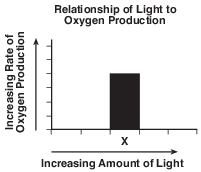
If a student supplies more light than was received during trial X, a bar placed on the graph to represent the results would most likely be
(1) shorter than bar X and placed to the left of bar X
(2) shorter than bar X and placed to the right of bar X
(3) taller than bar X and placed to the left of bar X
(4) taller than bar X and placed to the right of bar X
Fertilized eggs containing embryos from the same species of alligator were incubated at different temperatures. The sex of the hatched offspring is shown in the table below.

A review of this data could lead to the conclusion that
(1) the most alligator eggs hatched if incubated at 26°C
(2) the sex of the offspring depends on the incubation temperature
(3) female alligators develop at higher temperatures
(4) temperature doesn’t affect the survival of alligator embryos
The graph below shows changes in the populations of hares and lynx in a Canadian ecosystem.
Changes in Hare and Lynx Populations

Source: Adapted from http://lbyiene-jardin-wikispaces.com
Which statement about the hares and lynx can be supported with information from the graph?
(1) The hare is the predator of the lynx because it is a larger animal.
(2) The lynx population begins to drop after the hare population drops.
(3) Both populations go through cycles due to the succession of plant species.
(4) Both populations have a carrying capacity of 3000 per square kilometer.
An investigation was carried out to determine which of three antibacterial soaps is most effective. Four petri dishes labeled A, B, C, and D were set up. The same amount and type of bacteria was added to each dish. Next, 2 mL of a different brand of soap were added to dishes B, C, and D. Then, 2 mL of water were added to dish A, instead of soap. The dishes were incubated at 37°C for 24 hours. At the end of the investigation, the amount of bacteria in each dish was determined. Dish D had the least bacteria. It was concluded that the soap in dish D was the most effective soap to use against bacteria.
Which statement best describes the validity of this conclusion?
(1) The conclusion is not valid since the same amount of bacteria was used in each dish.
(2) The conclusion is valid since too small a sample of bacteria was used in this investigation.
(3) The conclusion is valid since the amounts of bacteria were measured at the end of the investigation.
(4) The conclusion might not be valid since the investigation was carried out only once.
In recent years, biologists have noticed that honeybees responsible for pollinating food crops across the United States are dying at an alarming rate. Farmers, economists, and biologists are very worried about the impact that the loss of honeybees might have on the food supply.
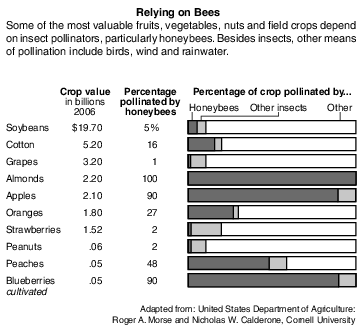
Peach blossom pollinations could be at risk if there is a total loss of honeybee populations in areas where peaches are grown. Which action would be most likely to help peach growers stay in business and be able to produce good-sized crops of peaches?
(1) Hire scientists to find a way to kill other pollinating insects in the area so there are more peach blossoms for the honeybees to pollinate.
(2) Hire researchers to identify which other native insects are able to pollinate peach blossoms and find a way to increase their populations.
(3) Encourage the peach growers to plant other kinds of fruit instead of peaches.
(4) Genetically engineer peach trees to be able to reproduce without producing any fruit (peaches) or seeds.
Super-Size It?
The American Academy of Pediatrics has noted an increase in the population of children with disorders that are usually associated with older adults, such as diabetes. Observers of American culture point to the trend to “super-size” food servings as a possible cause. Larger servings might encourage children of today to eat more fats and sugars than children ate a generation ago.
In an attempt to determine if there is a relationship between diet and the development of diabetes in children, a study was done which surveyed a group of children regarding their eating habits and whether or not they were diabetic. When the survey results were collected, the data were used to organize the children into two groups based on their responses, and then the data were analyzed.
Discuss this investigation. In your answer, be sure to:
• state the hypothesis being tested in this investigation [1]
• identify one survey response that was most likely used for organizing the children into two groups [1]
• state what survey results would support the hypothesis stated above [1]
The student’s response to the bulleted items in the question need not appear in the following order.
• 6 Allow 1 credit for stating the hypothesis being tested in this investigation. Acceptable responses
• include, but are not limited to:
• — Eating a diet with excessive amounts of fats and sugars has no connection with developing diabetes.
• — Children who are diabetic have been eating more “super-sized” portions than those who are not.
• — Children who are diabetic have been (or have not been) eating greater amounts of fats and sugars compared to those who are not.
• — If children eat more fats and sugars, then they are more likely to be diabetic or have disorders.
• — There is a relationship between diet and diabetes.
• Note: Do not allow credit for a hypothesis in the form of a question.
• 7 Allow 1 credit for identifying one survey response that was most likely used for organizing the children into two groups. Acceptable responses include, but are not limited to:
• — The children were divided based on whether or not they were diabetic.
• — The children were divided based on whether or not they ate “super-sized” portions.
• — The children were divided based on different eating habits.
• 8 Allow 1 credit for stating what survey results would support the hypothesis stated above.
• Responses will vary based on the specific hypothesis stated and how the student proposed organizing the children into two groups. Acceptable responses include, but are not limited to:
• If a connection between diabetes and diet was hypothesized:
• — There would be data showing that more diabetic children ate more fats and sugars than children who were not diabetic.
• If no connection was hypothesized:
• — The data would show that about as many children with diabetes would have eaten more fats and sugars as children who were not diabetic.
In an experiment to test the effectiveness of a new vaccine, 50 rats received an injection of equal doses of the vaccine and 50 other rats received an injection of equal doses of a weak salt solution. Two months later, all of the rats received injections that contained equal doses of live, disease-causing organisms.
The experimental results are shown in the chart below.

Do the results of this experiment indicate that the vaccine is ready for human testing? Support your answer with information from the table. [1]
Allow 1 credit for indicating whether or not the vaccine is ready for human testing using
• information from the table. Acceptable responses include, but are not limited to:
• — No, seven rats getting sick is too many out of a total of 50.
• — A larger sample should be tested before testing on humans.
• — Only 100 rats were tested, so a larger sample size should be used before testing on humans.
• — Yes, because most rats did not develop the disease.
Pocket Mice
Pocket mice are small rodents that feed mainly at night and are preyed upon by owls, hawks, and snakes. Scientists studied pocket mice living on dark volcanic rock in both New Mexico and fifty miles away in Arizona. They recorded their data in the chart below.
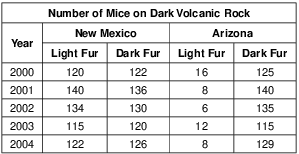
State one possible hypothesis that would explain the differences in the observed data between the two locations. [1]
Allow 1 credit. Acceptable responses include, but are not limited to:
• — There are few predators present in New Mexico, so fur color does not influence survival.
• — Predators can see the mice better if their fur color does not match the rock color in Arizona.
• — In New Mexico, both fur colors are equally suited to the environment, unlike Arizona.
• — If there were no owls/hawks in New Mexico, then the fur color would not matter.
• Note: Do not allow credit for a hypothesis written in the form of a question.
An experiment was carried out to determine the effect of exposure to ultraviolet (UV)
light on the growth of bacteria. Equal quantities of bacterial cells were spread on Petri dishes that are used to grow colonies of bacteria. Half of each dish was shielded from the UV light with a UV screen. The other half was exposed to UV light for various amounts of time. After the UV treatment, the bacteria were grown in an incubator for 24 hours and the number of colonies was counted.

The table below contains the data collected at different exposure times by counting the number of bacterial colonies on both the screen-covered side and unscreened side

Analyze the experiment that produced the data in the table. In your answer, be sure to:
• state a hypothesis for the experiment [1]
• state whether the results of the experiment support or fail to support your hypothesis. Support your answer [1]
The student’s response to the bulleted items in the question need not appear in the following order.
• 11 Allow 1 credit for stating a hypothesis for the experiment. Acceptable responses include, but are
• not limited to:
• — If bacteria are exposed to UV light, they will form fewer colonies than those not exposed.
• — Longer exposure to UV light will limit bacterial growth.
• — Exposure to UV light affects the growth of bacteria.
• — If bacteria are exposed to UV light, they will not form colonies.
• — Bacteria protected from UV light will produce more colonies.
• Note: Do not allow credit for a hypothesis written in the form of a question.
• 12 Allow 1 credit for stating whether the results of the experiment support or fail to support the
• student’s hypothesis and supporting the answer. Acceptable responses include, but are not limited to:
• — The experiment supports the hypothesis that longer exposure to UV light limits bacterial
• growth, since fewer colonies grew with longer exposure to UV light.
• — Support, because more exposure to UV light resulted in fewer bacterial colonies.
• Note: Allow credit only for an answer that is consistent with the student’s response to question 11 .
Sometimes a hypothesis is not supported. Yet, scientists consider the findings valuable. State one reason scientists would value an experiment that does not support the initial hypothesis. [1]
Allow 1 credit. Acceptable responses include, but are not limited to:
• — It helps scientists design new experiments or new hypotheses.
• — The new information can be used for future investigations.
• — An unsupported hypothesis provides scientists with information that is important to under-
• standing the scientific concepts being studied.
• — It tells scientists they are incorrect.
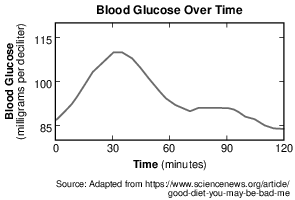
Based on the data and information provided, state whether or not it would be valid to conclude that bananas supply more glucose than cookies. Support your answer. [1]
Allow 1 credit for stating whether or not, based on the information provided, it would be valid to
• conclude that bananas supply more glucose than cookies and supporting the answer. Acceptable responses include, but are not limited to:
• — No, it is not valid because only a cookie was tested.
• — No, it is not valid because there is no data for bananas.
• — No, bananas were not tested.
Different plant species require different amounts of direct sunlight in order to flower. A student designed an experiment to determine the length of exposure to direct sunlight necessary for a specific plant species to produce flowers. The student collected the data below.
0 hours, 0% with flowers; 9 hours, 0% with flowers
1 hour, 0% with flowers; 5 hours, 90% with flowers
3 hours, 80% with flowers; 7 hours, 10% with flowers
At the end of the experiment, the student stated that if plants are exposed to more hours of daylight, they will always produce a greater percentage of flowers. Is this a valid conclusion? Support your answer. [1]
Allow 1 credit for no and supporting the answer. Acceptable responses include, but are not
• limited to:
• — No, this is not a valid conclusion because only one species of plant was tested.
• — No, more flowers were present at 5 hours than 7 or 9 hours.
• — No, there were no flowers at 9 hours.
Kaolin as a Spray to Control a Bean Pest
Spraying kaolin, a clay-like material, on the leaves of plants has been effective in reducing insect damage to plants that grow in temperate regions, but has not been tried in tropical areas.
Researchers in the tropical Andean region of South America have recently conducted experiments to see if kaolin can be used there to control the greenhouse whitefly, a significant pest of the region’s bean crops.
In the study, four groups of bean plants were used with the following treatments:

Should the group 3 kaolin treatments be considered as an acceptable alternative control method to the group 2 insecticide treatment for whiteflies? Support your answer with data from the chart. [1]
Allow 1 credit for stating whether the kaolin treatments should be considered as an acceptable
• alternative control method for whiteflies and supporting the answer with data from the chart.Acceptable responses include, but are not limited to:
• — The insecticide was about 90% effective, while both kaolin treatments were only about 80%
• effective. However 80% effectiveness is still quite effective, so it could be a good alternative.
• — The kaolin was only 10% less effective, but it was found to have other positive effects in the
• plants that could make it more desirable to use.
• — The kaolin treatments were only 80% effective, which is 10% less than the effectiveness of
• the insecticide, so it is not as good an alternative.
• — Even though the pesticide was the most effective (90%), it could damage other organisms
• in the area, so it should be replaced.
• — It should be considered as an acceptable method because it kills the majority of whiteflies.
Dr. Liz Hadly studied the ecology of Yellowstone National Park for 30 years, specifically the amphibians inhabiting the park for 20 of those years. Dr. Hadly studied 46 ponds in 1992-1993. Of these, 43 supported amphibians. From 2006-2008, only 38 of the original 46 ponds contained water. The graph below represents population data for four amphibian species collected by Dr. Hadly during 1992-1993 and 2006-2008.
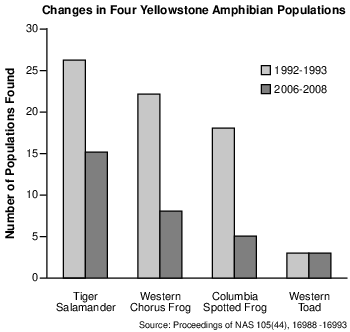
Explain why such a long-term study is more likely to be accepted by Dr. Hadly’s peers than one that took place over a shorter period of time. [1]
Allow 1 credit. Acceptable responses include, but are not limited to:
• — A longer study provides more data that will result in the findings being more reli-
• able/accurate.
• — It is more likely that other scientists repeating her work will obtain similar results.
• — There would be more data.
Secondhand Smoke and Estrogen
A fertility researcher conducted a study of pregnant women. The researcher’s hypothesis was that the estrogen levels of pregnant women who were exposed to daily secondhand cigarette smoke would be higher than estrogen levels of pregnant women not exposed to daily secondhand smoke.
The researcher measured the estrogen levels of eight pregnant women each week throughout their pregnancy. Four of the women lived in houses with heavy smokers, the other four did not. The women’s ages varied from 19 to 42 years old. Six of the women were pregnant with girls, one was pregnant with a boy, and one was pregnant with twin boys. The research was submitted for peer review.
Analyze this experiment. In your answer, be sure to:
• identify one error in the researcher’s experimental design [1]
• identify one way, other than affecting estrogen levels, that secondhand smoke could affect a developing embryo [1]
• explain why the process of peer review is an important step in this research [1]
The student’s response to the bulleted items in the question need not appear in the following order.
• 18 Allow 1 credit for identifying one error in the researcher’s experimental design. Acceptable
• responses include, but are not limited to:
• — The sample size for the experiment was too small.
• — There were not enough women in the study.
• — The range of ages added a second variable.
• — There were fetuses of different genders.
• — There were too many variables.
• 19 Allow 1 credit for identifying one way, other than affecting estrogen levels, that secondhand smoke could affect a developing embryo. Acceptable responses include, but are not limited to:
• — It could lead to miscarriages/premature labor/birth.
• — The babies born could have a lower birth weight.
• — They could have asthma/birth defects/addiction.
• — They might receive less oxygen/nutrients.
• 20 Allow 1 credit for explaining why the process of peer review is an important step in this research.
• Acceptable responses include, but are not limited to:
• — Other scientists may find errors that the original researchers did not.
• — Other scientists could repeat the experiment to confirm the result.
• — Peer review allows other researchers to evaluate the results of an experiment.
• — Peer review improves the validity of the study.
